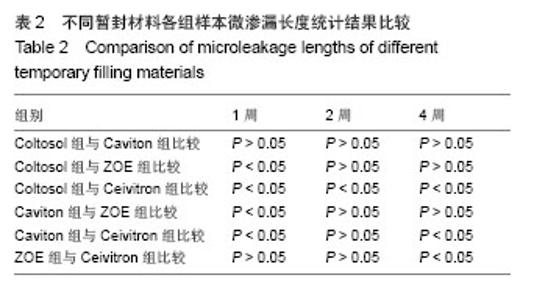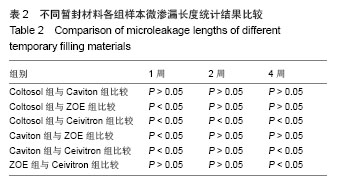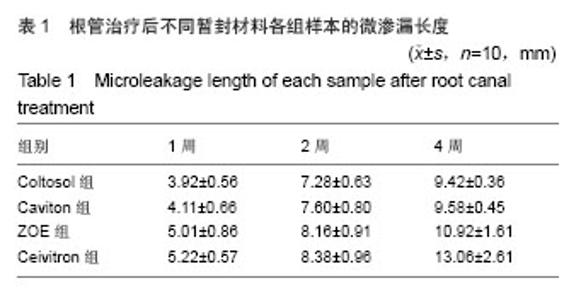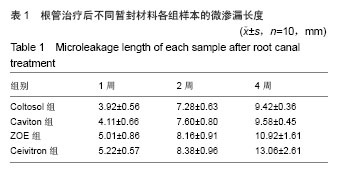Chinese Journal of Tissue Engineering Research ›› 2015, Vol. 19 ›› Issue (3): 405-409.doi: 10.3969/j.issn.2095-4344.2015.03.014
Previous Articles Next Articles
Influence of four kinds of temporary fillings on coronal microleakage of endodontically treated teeth
Zhang Run-zhen, Xia Rong, Ji Zhang-zhang
- Department of Stomatology, the Second Affiliated Hospital of Anhui Medical University, Anhui 230601, Hefei Province, China
-
Online:2015-01-15Published:2015-01-15 -
About author:Zhang Run-zhen, Master, Attending physician, Department of Stomatology, the Second Affiliated Hospital of Anhui Medical University, Anhui 230601, Hefei Province, China -
Supported by:the Medical Research Foundation of Anhui Medical University, No. 2012xkj064
CLC Number:
Cite this article
Zhang Run-zhen, Xia Rong, Ji Zhang-zhang. Influence of four kinds of temporary fillings on coronal microleakage of endodontically treated teeth[J]. Chinese Journal of Tissue Engineering Research, 2015, 19(3): 405-409.
share this article

2.2 统计学分析结果 相同暂封时间、不同暂封材料之间比较:暂封1周时,Coltosol组微渗漏长度短于ZOE组、Ceivitron组(P < 0.05),Caviton组微渗漏长度短于ZOE组、Ceivitron组(P < 0.05),Coltosol组与Caviton组微渗漏长度比较差异无显著性意义,ZOE与Ceivitron微渗漏长度比较差异无显著性意义;暂封2周时,仅Coltosol组与Ceivitron组微渗漏长度比较差异有显著性意义(P < 0.05),其余各组之间均无明显区别;暂封4周时,Coltosol组、Caviton组、ZOE组微渗漏长度短于Ceivitron组(P < 0.05),Coltosol组与Caviton组、ZOE组微渗漏长度比较差异无显著性意义,Caviton组与ZOE组微渗漏长度比较差异无显著性意义,具体情况见表2。 相同暂封材料、不同暂封时间比较:经统计学分析,4 种暂封材料,在暂封1,2,4周后,微渗漏长度比较差异均有显著性意义(P < 0.05)。"

| [1]李琴,王继春,张志,等.临床根管治疗失败原因分析及预防措施[J].北方药学,2012,9(3):73-74.
[2]Ozcan E, Eldeniz AÜ, Aydinbelge HA. Assessment of the sealing abilities of several root canal sealers and filling methods.Acta Odontol Scand.2013;71(6):1362-1369.
[3]吴婷,王禹琨,马廷建.根管充填材料的应用比较及评价[J].中国组织工程研究,2012,16(51):9663-9670.
[4]王家霞,刘恩伟,姜广水.根管充填封闭性的体外研究[J].山东医学高等专科学校学报,2014,36(2):113-115.
[5]Divya KT,Satish G,Srinivasa TS,et al.Comparative evaluation of sealing ability of four different restorative materials used as coronal sealants: an in vitro study.J Int Oral Health. 2014; 6(4):12-17.
[6]Naseri M,Kangarlou A,Khavid A,et al.Evaluation of the quality of four root canal obturation techniques using micro-computed tomography.Iran Endod J. 2013;8(3):89-93.
[7]Angerame D,De Biasi M,Pecci R,et al. Analysis of single point and continuous wave of condensation root filling techniques by micro-computed tomography.Ann Ist Super Sanita. 2012; 48(1):35-41.
[8]Lipski M,Wo?niak K,Lichota D,et al. Root surface temperature rise of mandibular first molar during root canal filling with high-temperature thermoplasticized Gutta-Percha in the dog. Pol J Vet Sci.2011;14(4):591-595.
[9]Kilic K,Er O,Kilinc HI,et al.Infrared thermographic comparison of temperature increases on the root surface during dowel space preparations using circular versus oval fiber dowel systems.J Prosthodont.2013;22(3):203-207.
[10]Ulusoy OI,Y?lmazo?lu MZ,Görgül G.Effect of several thermoplastic canal filling techniques on surface temperature rise on roots with simulated internal resorption cavities: an infrared thermographic analysis.Int Endod J 2014.doi: 10.1111/iej.12297. [Epub ahead of print]
[11]Tasdemir T,Yesilyurt C,Ceyhanli KT,et al.Evaluation of apical filling after root canal filling by 2 different techniques.J Can Dent Assoc. 2009;75(3):201a-201d.
[12]Bernabé PF,Gomes-Filho JE,Bernabé DG,et al.Sealing ability of MTA used as a root end filling material: effect of the sonic and ultrasonic condensation.Braz Dent J. 2013;24(2): 107-110.
[13]Viapiana R,Guerreiro-Tanomaru JM,Tanomaru-Filho M,et al.Investigation of the effect of sealer use on the heat generated at the external root surface during root canal obturation using warm vertical compaction technique with System B heat source.J Endod.2014;40(4):555-561.
[14]ZhangW,SuguroH,KobayashiY,et al.Effect of canal taper and plugger size on warm gutta-percha obturation of lateral depressions.J Oral Sci.2011;53(2):219-224.
[15]Camps J,Pashley D.Reliability of the dye penetration studies. J Endod. 2003;29(9):592-594.
[16]Kardon BP,Kuttler S,Hardigan P,et al.An in vitro evaluation of the sealing ability of a new root-canal-obturation system.J Endod. 2003;29(10):658-661.
[17]Kazem M, Mahjour F, Dianat O,et al. Root-end filling with cement-based materials: An in vitro analysis of bacterial and dye microleakage.Dent Res J (Isfahan). 2013;10(1):46-51.
[18]Xu Q, Ling J, Cheung GS, et al. A quantitative evaluation of sealing ability of 4 obturation techniques by using a glucose leakage test.Oral Surg Oral Med Oral Pathol Oral Radiol Endod. 2007;104(4):e109-113.
[19]Mente J, Ferk S, Dreyhaupt J, et al. Assessment of different dyes used in leakage studies.Clin Oral Investig. 2010;14(3): 331-338.
[20]沈睛昳,傅柏平.染料渗透与电子显微镜观察牙本质粘接界面微渗漏结果的相关性分析[J].浙江医学,2003,25(2):82-84.
[21]Britto LR, Borer RE,Vertucci FJ, et al. Comparison of the apical seal obtained by a dual-cure resin based cement or an epoxy resin sealer with or without the use of an acidic primer.J Endod.2002;28(10):721-723.
[22]Reeh ES, Combe EC. New core and sealer materials for root canal obturation and retrofilling.J Endod.2002;28(7):520-523.
[23]Koagel SO,Mines P,Apicella M,et al.In vitro study to compare the coronal microleakage of Tempit UltraF, Tempit, IRM, and Cavit by using the fluid transport model. J Endod. 2008; 34(4):442-444.
[24]白莲,张成飞,王晓灵,等.五种髓腔暂封材料冠方微渗漏的体外评价[J].临床口腔医学杂志,2005,21(7):423-425.
[25]Erdemir A,Eldeniz AU,Belli S.Effect oftemporary filling materials on repair bond strengthsof composite resins. J Biomed Mater Res B Appl Biomater. 2008;86(2):303-309.
[26]Anderson RW, Powell BJ, Pashley DH. Microleakage of three temporary endodonticrestorations. J Endod. 1988;14(10): 497-501.
[27]Liberman R, Ben-Amar A, Frayberg E, et al.Effect of repeated vertical loads on microleakage of IRM and calcium sulfate- based temporary fillings.J Endod. 2001;27(12):724-729.
[28]Laustsen MH,Munksgaard EC,Reit C,et al.A temporaryfilling material may cause cusp deflection,infractions and fractures in endodonticallytreated teeth. Int Endod J.2005;38(9):653-665.
[29]张立立,刘泓.三种根管暂封材料冠方微渗漏的体外研究[J].中国美容医学,2012,21(7): 1211-1213.
[30]许姚,沈海燕.3种暂封材料在根管治疗中冠方微渗漏的体外效果观察[J].口腔医学,2011,31(12):727-729.
[31]Madarati A, Rekab MS,Watts DC,et al.Time-dependence ofcoronal seal of temporary materials used in endodontics. Aust Endod J.2008;34(3):89-93.
[32]Holland R, Manne LN, de Souza V, et al.Periapical tissue healing after post spacepreparation with or without use ofa protection plugand root canal exposure to theoral environment study in dogs. Braz Dent J.2007;18(4):281-288.
[33]Barthel CR,Zaritzki FF,Raab WH,et al.Bacterial leakage in roots filled with different medicaments and sealed with Cavit.J Endod.2006;32(2):127-129.
[34]Vail MM, Steffel CL.Preference of temporary restorations and spacers: a survey of Diplomates of the American Board of Endodontists.J Endod.2006;32(6):513-515.
[35]Newcomb BE,Clark SJ,Eleazer PD. Degradation of the sealing properties of a zinc oxide-calcium sulfate-based temporary filling material by entrapped cotton fibers.J Endod. 2001;27(12): 789-790.
[36]张丽君,马楚凡,王忠义.氧化锌丁香油粘固剂对二种牙本质粘结剂粘结效果的影响[J].中华口腔医学杂志,2004,39(3):230-232.
[37]Barthel CR, Zaritzki FF, Raab WH,et al. Bacterial leakage in roots filled with different medicaments and sealed with Cavit.J Endod.2006;32(2):127-129.
[38]Weston CH, Barfield RD, Ruby JD,et al. Comparison of preparation design and material thickness on microbial leakage through Cavit using a tooth model system. Oral Surg Oral Med Oral Pathol Oral Radiol Endod.2008; 105(4):530-535.
[39]高燕,杨金玲,吕陶红等.暂时封固对根管治疗牙冠方微渗漏影响的体外研究[J].中华口腔医学研究杂志(电子版),2010,4(3): 268-274.
[40]Vergauwen TE,Michiels R,Torbeyns D,et al.Investigation of Coronal Leakage of Root Fillings after Smear Layer Removal with EDTA or Er,Cr:YSGG Laser through Capillary Flow Porometry. Int J Dent.2014;2014:593160. |
| [1] | Wang Jieqi, Zheng Meihua, Wu Hong, Li Xiaoyu, Xie Wenqiang. Microleakage from the crown to the root canal after post space preparation with different timing and remaining length [J]. Chinese Journal of Tissue Engineering Research, 2019, 23(10): 1552-1557. |
| [2] | Wang Ping-ting, Bao Yi-jun, Liu Ying . Properties of glass ionomer cements after addition of organic dye solutions [J]. Chinese Journal of Tissue Engineering Research, 2018, 22(26): 4116-4122. |
| [3] | Hu Xin, Wu Hui, Wang Lei, Zhang Qian, Ning Jia, Wu Wen-meng. The corrosion resistance of rotary nickel titanium root canal files [J]. Chinese Journal of Tissue Engineering Research, 2018, 22(18): 2866-2871. |
| [4] | Qi Lu, Wang Xing, Wu Pei-ling. Bonding effects of different adhesive materials with no ferrule effect in the dental restoration with CAD/CAM-fabricated one-piece fiber post-and-core after bypass obturation of oval root canals [J]. Chinese Journal of Tissue Engineering Research, 2018, 22(14): 2162-2167. |
| [5] | Wang Wang, Wu You, Liu Xing-rong. Influence of sodium hypochlorite irrigants on the bonding of fiber posts to root canals: a Meta-analysis [J]. Chinese Journal of Tissue Engineering Research, 2018, 22(10): 1634-1640. |
| [6] | Wan Na, Wang Xin-ying, Qi Lu, Yan Lei, Ma Jun-yue, Yin Yan-jiao, Gao Wen-hui, Wu Pei-ling. Clinical evaluation of nickel-titanium mechanical instruments in three different movement patterns combined with warm vertical compaction in the single-visit endodontic treatment [J]. Chinese Journal of Tissue Engineering Research, 2017, 21(6): 893-898. |
| [7] | Feng Xin-yan, Gao Cheng-zhi. ffect of ultrasonic cleaning of post space on the apical microleakage following treatment with two kinds of root canal sealers [J]. Chinese Journal of Tissue Engineering Research, 2017, 21(2): 254-259. |
| [8] | Lan Yu-yan, Huang Hai-xia, Fan Li-yuan, Pu Lin, Liu Min, Sun Li-bo. Influence of immediate or delayed post space preparation on the apical sealing ability of different root canal sealers [J]. Chinese Journal of Tissue Engineering Research, 2017, 21(10): 1483-1488. |
| [9] | Jia Zhi, Du Yu, Du Yuan, Jiang Chen. Interleukin-17 in apical exudates of periapical periodontitis treated with minocycline controlled-release formulation [J]. Chinese Journal of Tissue Engineering Research, 2017, 21(10): 1508-1513. |
| [10] | Yao Xi, Li Hong-mei, Li Yun-sheng, Dai Yong-yu. ProTaper Universal nickel titanium rotary file versus stainless-steel hand file: the security for root canal preparation [J]. Chinese Journal of Tissue Engineering Research, 2015, 19(8): 1250-1254. |
| [11] | Qi Lu, Wang Xing, Ma Jun-yue, Wu Pei-ling. Fracture resistance of different post-and-core repair systems after warm gutta filling [J]. Chinese Journal of Tissue Engineering Research, 2015, 19(38): 6167-6172. |
| [12] | Nie Er-min, Jiang Rui, Zhang Chun-yuan, Zeng Jin-di, Tan Ji-zhou. Temporary protection of cracked teeth using orthodontic band and resin temporary crown [J]. Chinese Journal of Tissue Engineering Research, 2015, 19(30): 4805-4809. |
| [13] | Li Xiao-jie, Hu Shu-hai, Ren Xiang, Zuo En-jun. Effect of alveolar bone height and fiber post length on the fracture resistance of endodontically treated maxillary central incisors [J]. Chinese Journal of Tissue Engineering Research, 2014, 18(43): 6966-6972. |
| [14] | Tang Zhen-yu, Jiang Shi-yong, Wang Hui, Lan Bi-feng. Clinical one-visit root treatment with nickel-titanium rotary instrument and ultrasonic irrigation unit for chronic apical periodontitis [J]. Chinese Journal of Tissue Engineering Research, 2014, 18(43): 6973-6978. |
| [15] | Zuo En-jun, Li Xiao-jie, Ren Xiang, Hu Shu-hai. Comparison of anterior teeth with flared root canals restored by fiber posts using three application methods [J]. Chinese Journal of Tissue Engineering Research, 2014, 18(25): 3966-3972. |
| Viewed | ||||||
|
Full text |
|
|||||
|
Abstract |
|
|||||

